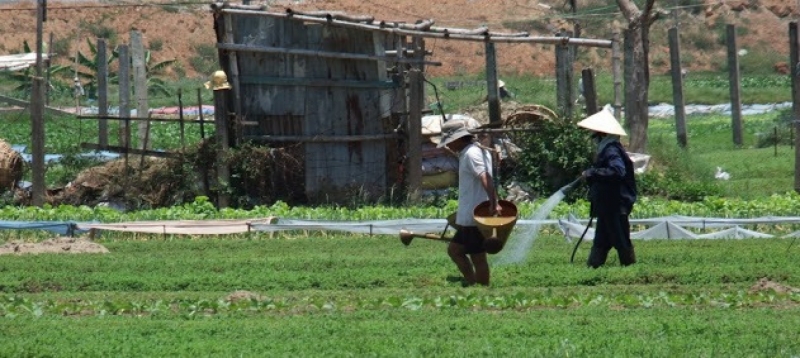



Somewhere in the north of Thailand, the soil is dry and the greenery has turned brown. In Myanmar's Central Dry Zone, problems with irrigation and water supply make good harvest almost an impossibility. In Vietnam and Cambodia, communities living along the Mekong and the Tonle Sap Rivers face a serious threat to their livelihood as Laos pushes ahead with the construction of hydropower plants in the lower stream of the Mekong. With climate change and the expected increase in demand for food, water and energy in the next years, these conditions are a stark reminder that our social, economic and environmental systems are interdependent and interrelated.
The Water-Energy-Food Security Nexus
The subject of the Bonn Conference in November 2011, the nexus approach of water, energy and food security is presented as one of the solutions for achieving a green economy, one that the UN Environment Programme (UNEP) characterizes as resulting to “improved human well-being and social equity, while significantly reducing environmental risks and ecological scarcities.”
Indeed, the nexus makes sense if one looks at the global statistics: Around a billion people need access to safe drinking water; more than a billion lacks access to electricity; and almost a billion of the world’s peoples are undernourished. The relationship among the three cannot be discounted. We need water to grow our crops and to generate the electricity to power farm machinery and equipment. Using it for hydropower, however, can have adverse impacts on biodiversity and ecological health, which in turn may have subsequent effects on the availability of food and our overall nutrition.
The water-energy-food security nexus provides an integrated, systemic approach to viewing the relationship and interaction of these three elements in the social, environmental and economic perspectives. The Food and Agriculture Organization (FAO) explains that, unlike other integrative frameworks such as the Integrated Water Resources Management where the ultimate priority of the approach is water, the nexus treats energy, water and food as not just interdependent but equal elements where not one resource deserves a stronger focus than the others.
Situating the nexus in the LMR

In Southeast Asia, there is perhaps no better illustration of the nexus’ critical importance than in the Lower Mekong region (LMR). Thailand’s need for energy to ensure maximum agricultural production, Lao PDR’s tapping of the Mekong River to generate power, Myanmar’s Dry Zone’s need for water and irrigation to address sanitary and agricultural needs, and Vietnam and Cambodia’s reliance on the Mekong and Tonle Sap rivers for improving livelihoods and food production point to the interdependence of water, energy and food. While it may seem that the Mekong River (water) is at the core of the countries’ activities and needs, there is a more complex link among the three elements of the nexus in each of the countries of the Lower Mekong. The use and demand for one resource may have expected gains and unintended consequences on the countries’ environment and economy.
Dr. Alex Smajgl’s presentation during the 2013 International River Symposium on the water-energy-food security nexus in the Mekong River pointed out the intricate link between the uses and needs of these three resources in the livelihoods of the countries. Continued hydropower projects in the Mekong River would mean an increase in the countries’ power capacity, resulting to more efficient industries, improved production, and higher national and regional GDP. Irrigation systems will improve and this means better rice yield and higher income for farmers. The latter, however, can also encourage the shift to commercial farming and a decrease in smallholder farmers. As Thailand has the most improved economy among the five countries, economic and industrial development will be at a much faster rate, encouraging migration from Lao PDR, Myanmar, and Cambodia.
Likewise, Stuart Orr noted in one of his papers that the decrease in the fish catch as the Mekong River is tapped for other industrial uses will increase the need for livestock protein, including resources for livestock production like pastureland and water. The price of protein sources may increase, and the most vulnerable to these price changes are the poor who have limited access to resources.
Achieving water, energy and food security
Addressing the usage and needs for water, energy and food in an equal and wholistic manner is essential to achieving sustainable development. With hydropower projects in the Mekong bringing the debates to more intense levels, the rationale of the 2013 Workshop on Food Security in the Mekong is worth noting: The challenge is to go beyond the hydropower discussions and achieve concerted efforts in the work of the three sectors.
Holger Hoff during the Bonn 2011 Conference also mentioned a number of possible opportunities worth exploring to achieve water, energy and food security. These include promoting recycling and reducing wastage to improve resource productivity; laying down institutional policies to encourage equitable sharing of benefits; and awareness-raising to encourage shifts to more sustainable lifestyles and consumption patterns, among others.
But if anything, stakeholder collaboration and dialogue remains the utmost priority in order to achieve water, energy and food security in the Lower Mekong. In this region where countries share borders and resources, multi-stakeholder engagement is a key ingredient in facilitating more cohesive actions. Dialogues between governments and the civil sector will allow more efficient harnessing of resources. Ultimately, the goal is to create a shared and regional (rather than national) understanding among the countries on how they can work cohesively towards water, energy and food security.